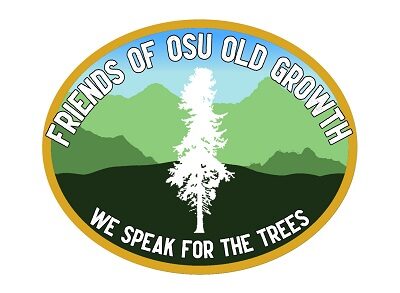Despite unprecedented community concern, OSU has stubbornly moved forward with the ‘Woodpecker Phase 1’ logging project (described in my previous blog piece: OSU’s ‘Woodpecker Thin’ Reveals Greed and Arrogance of College Leaders).
For comprehensive photos of the destruction, visit the ‘Gallery‘ section of our website.
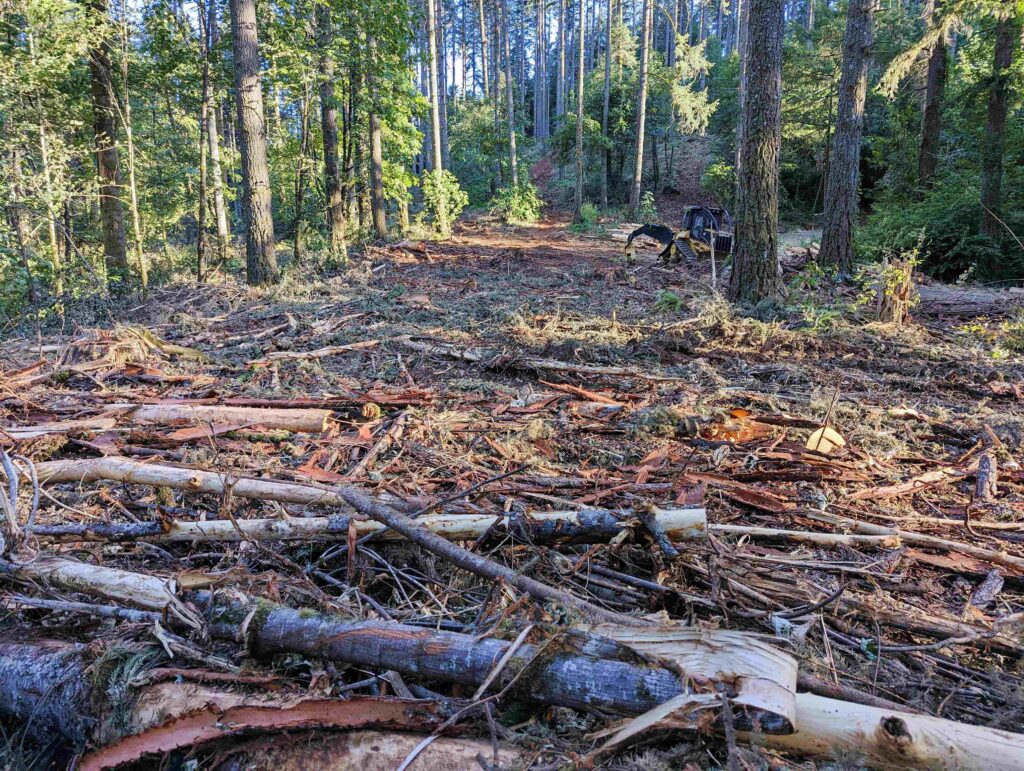
‘Woodpecker Phase 1’: the dean justified this kind of devastation by writing, “While timber harvests may create temporary disturbances, the college carefully considers forest aesthetics in projects near popular recreation areas.” This project, “represents…the retention of legacy trees and provides research and demonstration projects achieving structural and compositional complexity on the forest“, according to dean DeLuca.
In defiance of a front-page article in the Gazette Times, a flood of Letters-to-the-Editor, and dozens of thoughtful emails sent to president Murthy and the OSU Trustees, OSU began logging near Peavy Arboretum in early July. Neither the dean nor OSU administration gave any public notice that the pause (announced by associate dean Ober in the recent GT article) was over. OSU leaders have shown no willingness to engage with concerned citizens. President Murthy won’t even acknowledge receipt of emails, let alone agree to meet with conservation leaders (I’ve asked twice).
Hired to lead or impede?: OSU’s so-called leaders have predictably decided that wearing their Teflon suits is an appropriate tactic for avoiding the public accountability and transparency called for by Oregon law1. President Murthy has once again demonstrated her stubborn determination to avoid even a hint of engagement with critics of OSU’s outdated forestry practices. She retreated behind her minister of propaganda (Rob Odom) and her “Cheryl Ramberg-Ford and Allyn C. Ford (i.e. Roseburg Forest Products) Dean”, Thomas DeLuca2. Our many compelling emails to the president and trustees received the same disingenuous, cloned reply from OSU’s marketing department.
Building vs. squandering trust: This cavalier disregard for community sentiment is profoundly disappointing. It stands in stark contrast to the response of College leaders after the old-growth cutting debacle of 2019. The dean’s predecessor framed the 2019 cutting as a “mistake”, held a number of community listening sessions in response, and made several notable concessions. This included setting aside 36 acres of old growth and committing the College to a “collaborative planning process” (a commitment the current dean has broken in spades).

One of many large, old trees cut in the name of “creating structural diversity” in OSU’s ‘Woodpecker Phase 1’ cut. The dean claims this thinning was done, “to support the health and vigor of the forest”.
Promised review never shared with public: In the recent GT article, dean DeLuca reported that he would have an ecologist and silviculturist (forestry expert) review their current logging project for compliance with the 2005 McDonald-Dunn Plan (as if meeting the relatively low standards of nearly two decades ago would give them a “green light” to proceed). To our knowledge (and that of the GT reporter), there was no public follow-up from the dean. We fully anticipated he’d find “experts” who’d support his agenda, but failing to even disclose their names and their foregone conclusions to the public sets a new low. It reminds one of the so-called “panel of experts” who developed OSU’s forest modeling behind closed doors. Nearly two months after OSU’s forest planning meeting, we’re still waiting for associate dean Ober to honor her commitment to disclose their identities.

Roughly 1/3 to 1/2 of the largest trees were cut in this section of mature forest. The dean claims, “This selective thinning will continue to allow the largest trees in the area the room they need to grow and set the stage for future multi-aged forest conditions, while also helping restore conditions for native oak to grow and thrive. The largest and legacy trees will be retained…”. No signs of the oak savanna ecosystem that the dean claims this “harvest” will restore are visible.
Dean lashes out with personal attack: In a recent email sent to the entire College of Forestry distribution, dean DeLuca portrayed community concerns as, “an orchestrated misinformation campaign started ~3 weeks ago by a neighbor of the McDonald-Dunn who has long opposed active forest management on the college forests.” In short, he has chosen to make a thinly-veiled personal attack by framing me as an ill-informed, disgruntled trouble-maker.
The dean referred to our many concerns as a, “fearmongering campaign” that, “reflects a lack of understanding of the objectives of the harvest or the larger picture of management on the McDonald-Dunn“. The dean’s letter is sprinkled with loaded language. He wrote, “It is never easy to have your work or reputation disparaged, especially when what is being said is riddled with inaccuracies…it is sad that a harvest with the right intentions and positive motivations is being sensationally case as an environmental disaster. It is not a disaster; it is an appropriate treatment and demonstration project that is forward looking…“. It is regrettable that the dean of our public university feels compelled to respond with such hostility, resentment and misinformation.
For those who are not acquainted with the dean’s tactics and language, I can attest that this behavior is nothing new. From our very first meeting in 2020 (when he labeled me a “lightning rod”) to the disparaging emails sent to my supporters3, to his long-standing refusal to acknowledge the questions I’ve asked in emails, the dean has demonstrated a glaring disregard for OSU’s ethical standards.
OSU launches “orchestrated misinformation campaign”: In an unprecedented series of communications, the dean and his PR team have attempted to justify the ‘Woodpecker’ logging behind a façade of misleading and inaccurate information. A 4-page, “Woodpecker Harvest Background” was attached to the dean’s email to the College of Forestry. Another version, (with a 3-page, “Woodpecker Harvest FAQ” section) targeted the general public via the College’s website and their social media outlets. A shorter, 2-page summary has also been widely distributed via the College’s email updates. This flurry of lengthy, defensive communications has exposed College leaders in crisis and an administration that is deaf to community concerns.
For a comprehensive, illustrated rebuttal to OSU’s propaganda about the ‘Woodpecker’ “harvest” read:
Propaganda vs. Fact – Exposing OSU’s False Narrative about the
‘Woodpecker Phase 1’ Harvest
“Working Forests Forever!”: All of OSU’s communications share a common narrative: these are “working forests“…”OSU-owned real property“…that, “the university is not required to open to the public“. Following this logic, these forests were always intended to be logged, not become old-growth – so that’s how they shall be managed in perpetuity. He wrote that these forests, “do not reflect the natural structure nor function of the historical forests of the area…oak savannah and open conifer forests, stewarded by the Kalapuya for generations prior to Euro-American colonization“. There’s a clear message of absolute sovereignty, historical precedence and the College’s outdated prioritization of timber production – all hidden behind a smokescreen of oak restoration and deference to the Tribes.
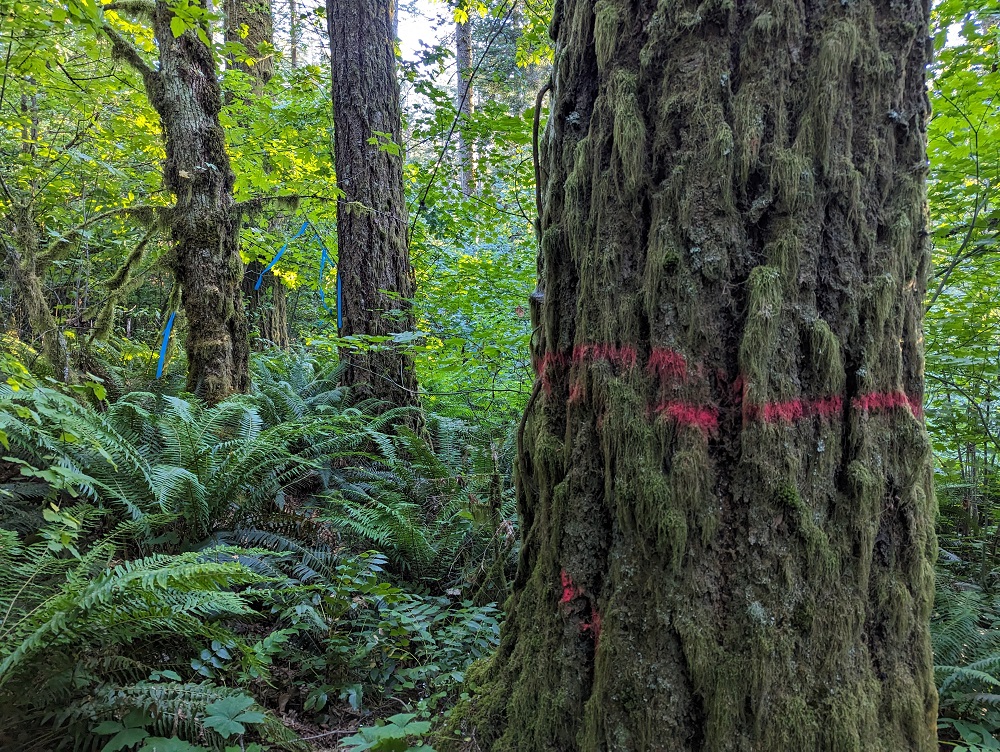
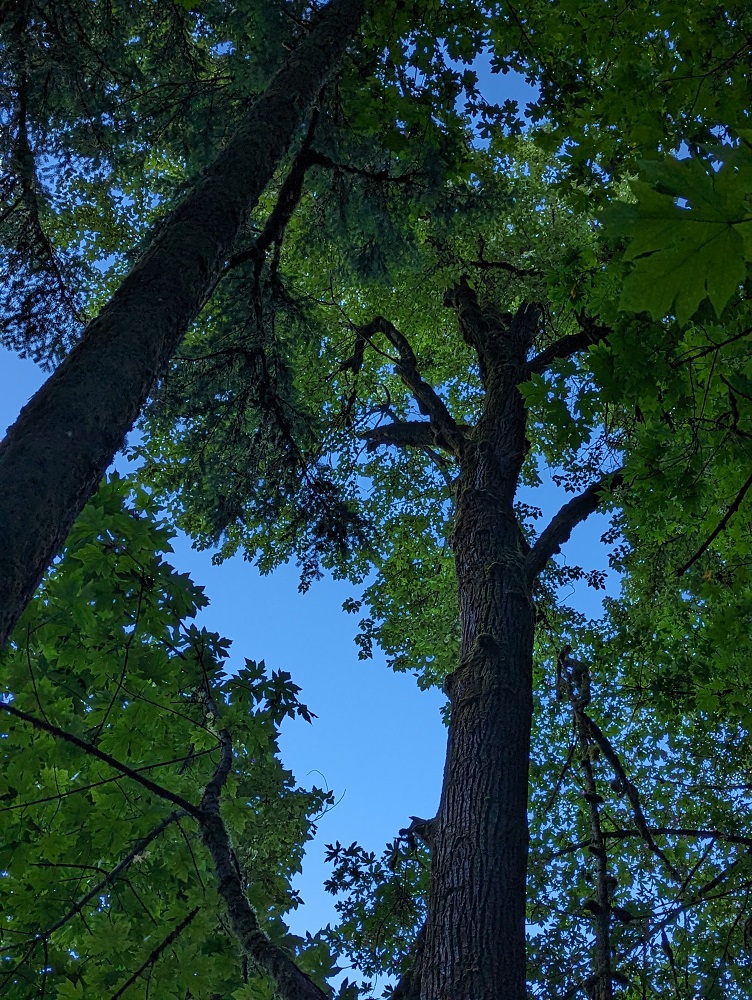
These images from before the ‘Woodpecker’ cutting began show the older forest characteristics which were typical of the 108 year-old forest above Cronemiller Lake. A substantial number of older trees were scattered across the landscape. The dean has falsely characterized this section of the forest as, “dominated by dense stands of Douglas-fir“.
Oak restoration at the request of the Tribes: OSU’s 2-page ‘Woodpecker’ summary states:
“We have received strong guidance from Oregon Tribal Nations that as a land-grant institution, we are obligated to do oak savanna restoration on College forests. Portions of the Woodpecker project fulfill this request from Oregon Tribes.”
Seeing just how many large trees were cut, one wonders how this fits with Indigenous stewardship values. OSU’s Director of Tribal Initiatives, Dr. Cristina Eisenberg, has stated, “Our forests are in grave danger in the face of climate change.” She believes that, “braiding together Indigenous knowledge with western science” can, “develop a path forward that makes our forests more resilient to the threats they are facing.“4 I would ask her how she reconciles OSU’s repeated clearcutting of older forests with Tribal values, but she won’t respond to the emails I’ve sent her. How does OSU’s Director of Tribal Initiatives reconcile the obvious destruction of so many older trees in the ‘Woodpecker’ harvest, with her Indigenous roots and values?
Oak restoration without oaks: In 2007, the College of Forestry established a Legacy Oaks Task Force to evaluate and rank oak resources on the McDonald-Dunn. The inventory covered more than 400 acres of oak groves on the research forests. It identified only two small oak groves near Peavy Arboretum (totaling ~3 acres). Only a single oak grove (approx. 1 acre in size) occurs in the 64-acre “Woodpecker Phase 1” project area (as shown in the map below). The 2008 Legacy Oaks Task Force report concluded there was no basis for restoring this small grove.
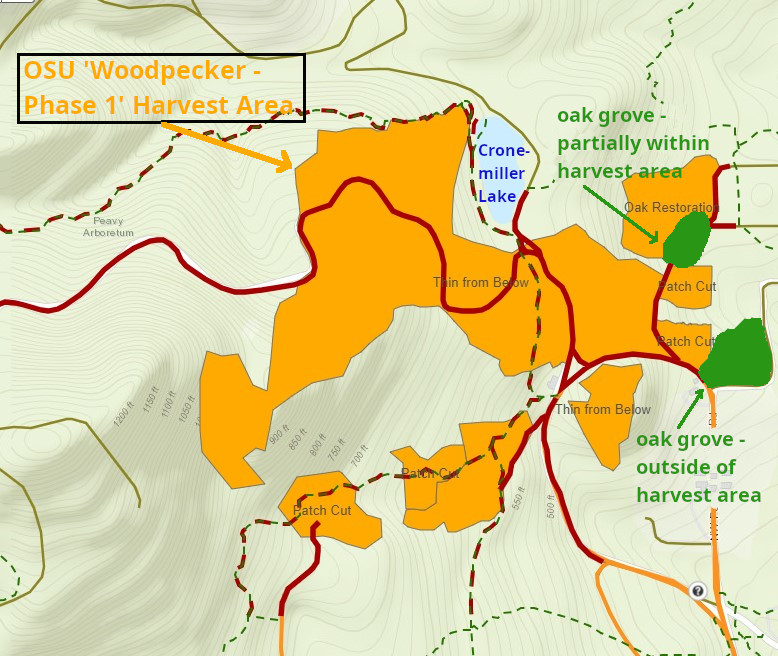
OSU’s 2008 Legacy Oak Task Force identified only a single, ~1-acre oak grove within the ‘Woodpecker’ harvest area, so it is misleading for the dean to use this as a justification for the harvest. The task force did not recommend restoration for this (“Tier 3”, low priority) grove .
Given the paucity of oak groves in the harvest area (and the complete lack of legacy oaks), it is astonishing the dean and his marketing folks would use this as a primary justification for their logging of this older Douglas-fir forest. It makes one wonder if they’ve even looked at the forest, or are deliberately trying to deceive. In any case, it doesn’t look good when the dean of the College is spreading blatant misinformation. The false promotion of oak restoration and reference to Tribal values gives the impression OSU is using these justifications to appeal to community sentiment.
A smokescreen of propaganda: The most glaring inaccuracies in the ‘Woodpecker’ area concern the mischaracterization of the forest and OSU’s claims of protecting older trees. OSU has described this forest as, “dominated by dense stands of Douglas-fir, planted and stewarded by the College of Forestry“, with mature trees that need to be, “released…to support the health and vigor of the forest by reducing competition for resources between mature trees growing too close together“. These obvious mischaracterizations give the false impression that the forest is an overgrown tree farm that needed to be thinned. Anyone who has hiked the popular Loop 36 Trail (or looked at the photos in our ‘Gallery‘) will understand that OSU’s mischaracterization is not a minor detail or difference of opinion. What we’re seeing is blatant mistruths.
You can pretty much assume everything OSU has told you about the ‘Woodpecker’ “harvest” is the exact opposite:
“Dense stands”? – Not even close!
Oak savanna? – Almost non-existent!
Trees competing? – Nope, they were collaborating and thriving!
Creating “structural diversity and improving wildlife habitat”? – Sorry, but the forest already had plenty of both before OSU damaged it!
Protecting the older trees? – Absolutely not, they have cut plenty of them!

OSU has relied on outdated forest science to justify the cutting of “co-dominant” trees (ones growing, “too close together”). Both of these trees were thriving before OSU cut the one on the right. OSU’s rhetoric surrounding the ‘Woodpecker’ “harvest” reflects an outdated understanding of trees as competitors rather than part of a thriving community connected through the mycorrhizal network.
A largely natural forest: The dean refers to the College’s history of cultivating these forests with the intent of harvest. But here, too, he doesn’t really know what he is talking about. An expert from the College of Forestry who knows the history of the ‘Woodpecker’ stand wrote, “There is no record that this area was planted long ago so it is probably all natural EXCEPT for the planting that was done in 2001.” The original planting map and notes (below) show that OSU replanted approximately 10 acres of the current (64-acre) ‘Woodpecker’ in 2001, after a thinning in 1999. The old-growth and mature Douglas-fir trees dispersed throughout the forest, and the lack of remnant oaks show this stand is largely of natural origins (and was not previously oak savanna) – contrary to what the dean has implied.
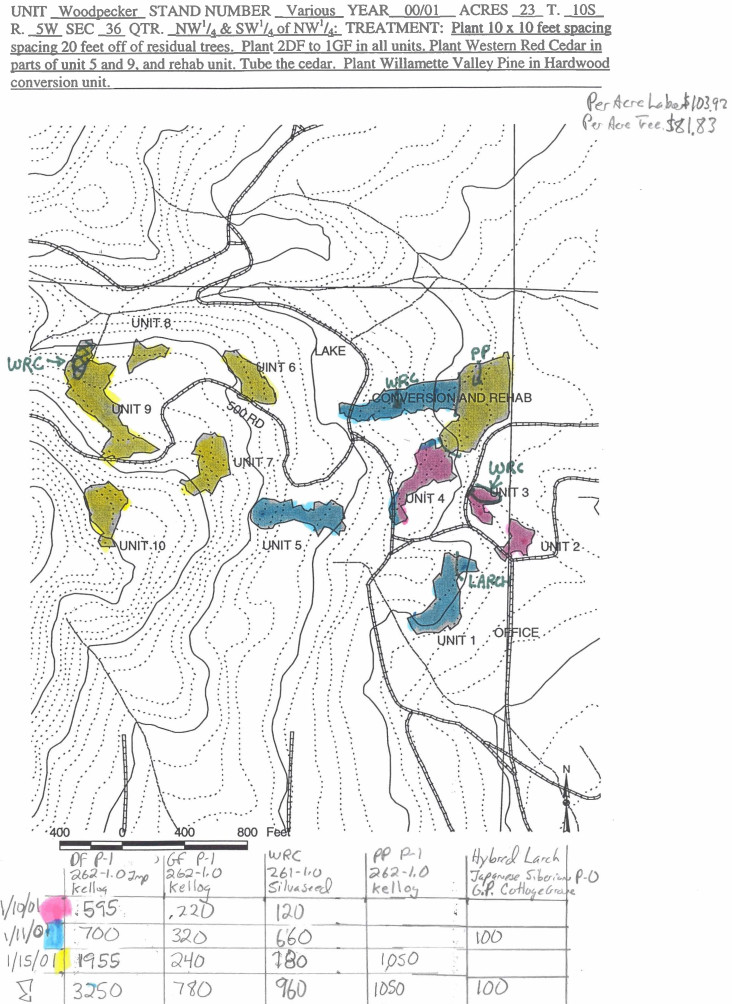
Tree-planting records from 2001 show a limited amount of planting within the current ‘Woodpecker’ project area. This and the current conditions of the forest lead one to conclude the stand was largely of natural origins (despite OSU’s claims to the contrary).
Cutting of older, “co-dominant” trees is unsupported by forest science: The dean’s argument for cutting older trees to, “support the health and vigor of the forest by reducing competition for resources between mature trees growing too close together” – is simply not supported by modern forest science. Dr. Jerry Franklin (an OSU alumnus, former faculty member, and world-renowned expert on old-growth forests) has stated, “These older trees are not competing with each other, they are collaborating. It is possible that some may die, but that is okay, because then there will be some nice snags.”

The three silvicultural approaches demonstrated in OSU’s ‘Woodpecker’ project seem disconnected from forest science and the conditions of the forest. The forest was already “structurally diverse and complex”, oaks are largely absent from this section of forest, and the older trees were not suffering from competition with each other.
Mycorrhizal connections show collaboration, not competition: With his background in soil science, I find the dean’s push to cut “competing trees” especially ironic. Roughly two decades of research by leading forest scientists, like Dr. Suzanne Simard, has shown that trees are connected via a network of mycorrhizal fungi in the soil. Rather than competing against each other, trees exchange nutrients and chemical signals as part of a collaborative community. Even trees of different species share nutrients. Dr. Simard’s book, Finding the Mother Tree: Discovering the Wisdom of the Forest, has predictably drawn the ire of old-school foresters who simply can’t seem to accept the implications of her reputable research. Dr. Simard did her post-graduate work at OSU and has been selected as a “2024 Alumni Fellow”. One can only hope Dr. Simard’s special status will convince the dean to change OSU’s outdated forestry practices to reflect her amazing research findings!
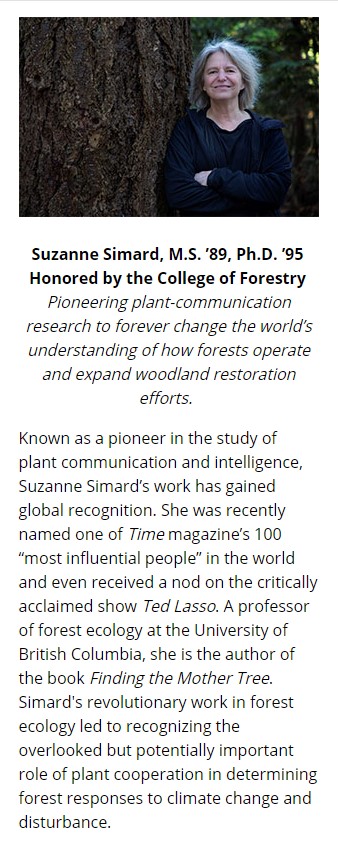
Studies by OSU’s own experts in forest carbon have also found that big trees store a disproportionate amount of above-ground carbon. If the dean and his foresters would just listen to OSU’s own experts (and his friend and former colleague, Dr. Franklin), they would stop cutting these older forests.
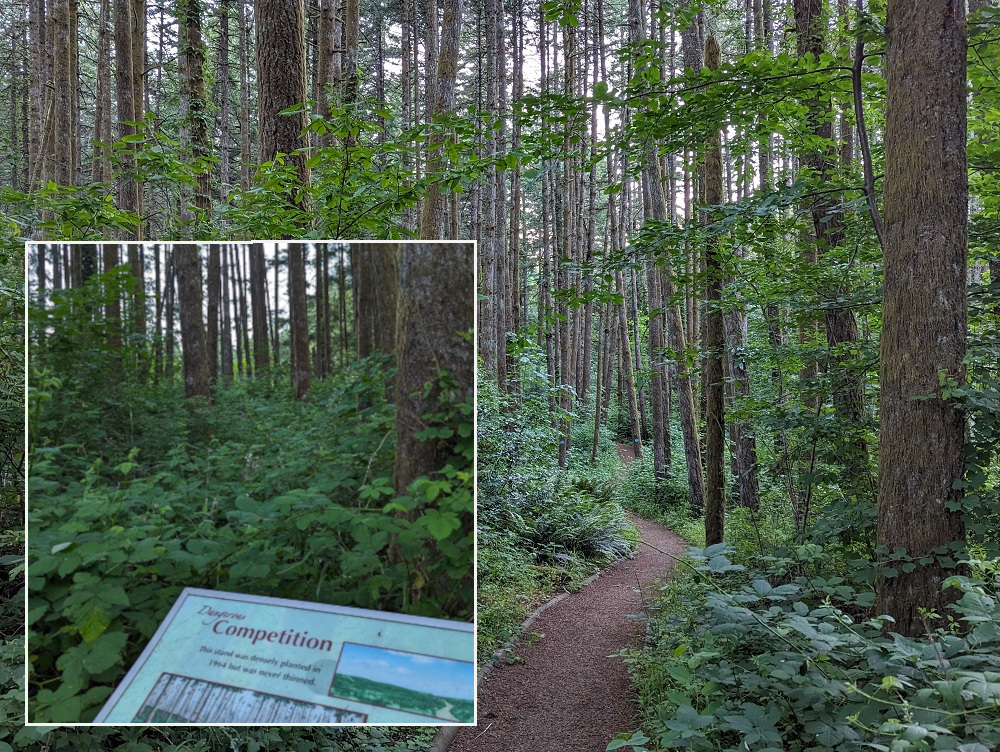
“Dangerous Competition“: An interpretive sign in this 60 year-old tree plantation located along the Calloway Creek Trail (outside the ‘Woodpecker’ area) warns against the dangers of not thinning forests. The structure of this forest is entirely different from the older, diverse stands which have now been thinned in the ‘Woodpecker’ harvest.
Follow the money…: OSU has claimed, “Due to the high costs associated with [selective harvesting].., there will be very limited revenue generated form the [‘Woodpecker’] harvest.” It also states, “Reserves are required to cover forest operation and staffing costs for a minimum of three years, should timber harvests temporarily decrease or economic conditions result in lower revenue from timber sales.” Finally, OSU claims that, “Revenue from harvests keeps the forests operational and open to recreational users.“
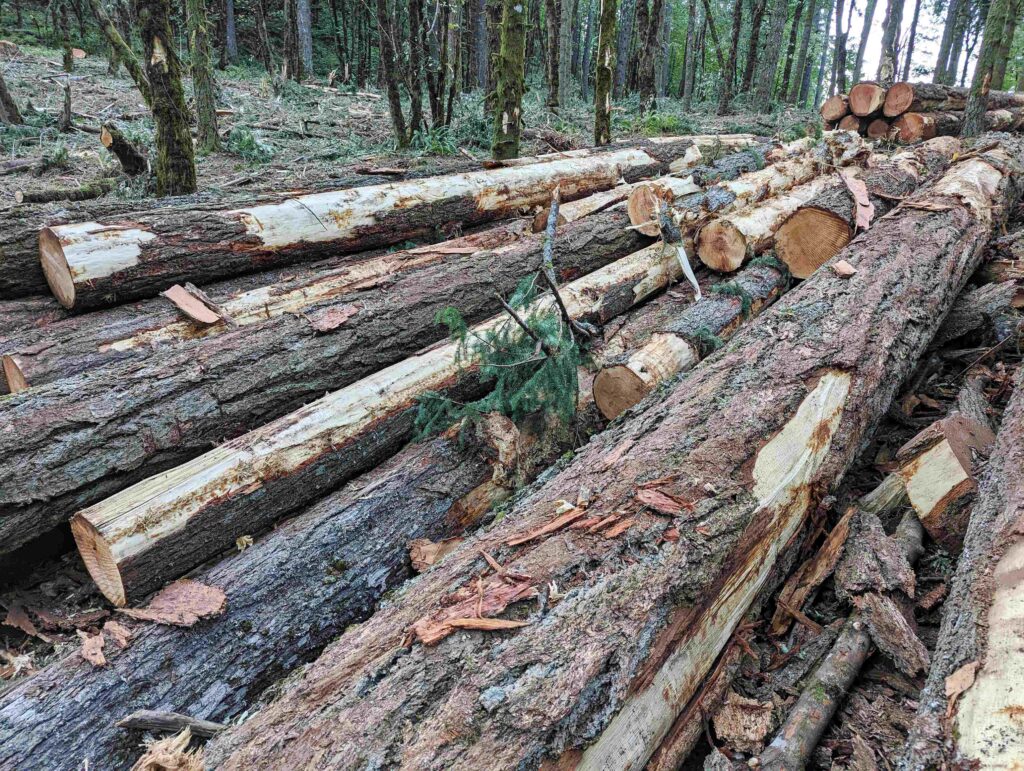
OSU’s claims about the limited revenue from this “harvest” make one question why they even decided to cut it in the first place. If they had simply left this rich, old forest alone it would have reached old-growth status in roughly half a century. One wonders if the underlying reason they cut so many old trees is simply their desire to keep it from becoming a “mature forest reserve”.
All three of OSU’s revenue statements are misleading. First and foremost, if OSU weren’t doing so much logging, its staffing and operational expenses would be significantly reduced. It wouldn’t need so many people to plan and oversee logging operations, tree-planting, slash-burning, road maintenance, herbicide applications, and related forestry activities. OSU has not provided any information about the expected revenue or harvest volume, but we can expect its logging contractors to make a substantial profit.
Between 2014 and 2023 (a 10-year period), OSU’s Research Forests generated $54.8M in “gross revenue”5. This is the raw economic value of the tens of millions of board feet of timber that has been extracted from these public forests over the past decade. The “net revenue” during this same period was $17.8M. This is the profit that the College of Forestry made after expenses ($37M) were taken into account. We can be certain a sizable chunk of this money went to pay the logging contractors. A substantial portion also paid the salaries of the OSU Research Forest staff. A public records request a few years ago reportedly revealed that only about 1% of the logging revenue went to research. To state that “any revenue that is generated will be reinvested directly back into the forest…” is simply not accurate. The numbers show that most of the revenue ($37M or ~68%) went toward expenses, not the forests. This lined the pockets of OSU’s contractors and paid the salaries of OSU staff who directed the logging, among other things.
Finally, it’s important to point out that most of the trail network in the McDonald Forest came about through the dedicated efforts of local volunteers, not OSU employees. OSU first hired a dedicated recreation coordinator for the forests in 2014. While this position is currently funded through timber revenue, College leaders could easily choose a different funding model (such as parking or user fees). Much of the trail construction and maintenance is still done by volunteers (e.g. Team Dirt members). College leaders seem to be implying that recreational use of the forests cannot continue without timber harvests. The reality is that recreational use of these public lands existed long before OSU officially sanctioned it – and will almost certainly continue with or without OSU’s timber harvests.

This old Douglas-fir tree was approximately 5 feet in diameter. OSU foresters targeted many large trees in their ‘Woodpecker’ harvest, despite their assertions to the contrary.
Worth more standing: While the gross revenue from logging these public forests is significant, it pales in comparison to the value an ecologically-intact McDonald-Dunn provides to our community. Besides the wide spectrum of ecological services (such as carbon sequestration, filtering and cooling the air, filtering and storing water, producing oxygen, and providing wildlife habitat), these forests are also a vital resource for recreation and mental health. Just being able to look out a window or over a rooftop and see the forested fringe surrounding our community reduces stress and adds to our general well-being. How does one place a value on the more than 150,000 recreational visits to these forests each year? How do you put a price on the countless hikes, bike rides and running adventures you’ve shared with family and friends over years or decades? Or the solitude and splendor of exploring an old-growth forest only minutes from town? It’s impossible to put a price on these experiences, but it certainly far exceeds the value of the logs sent to the mills. For most of us, it’s difficult to imagine Corvallis without these very special forests.
I hope that OSU’s leaders come to understand that the perpetuation of industrial forestry practices on these public forests is a crime against nature AND our community. Cutting these older forests destroys the best parts of the McDonald-Dunn. These forests are worth far more to society (and OSU) standing !
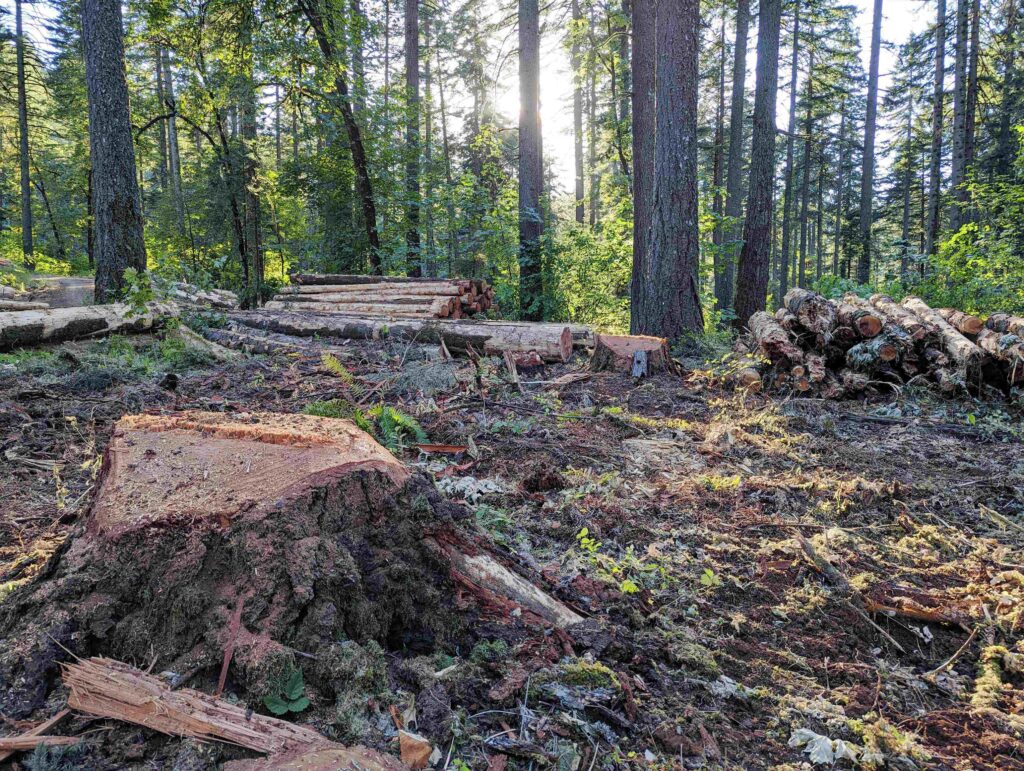
Another large tree cut by OSU’s logging contractor in the name of “supporting the health and vigor of the forest by reducing competition for resources“.
Postscript: In response to photos published in this blog piece and in our photo gallery, OSU’s VP of University Relations & Marketing sent the following email:

I have shared photos of OSU’s active logging operations extensively for more than five years. I have included them in numerous emails to several OSU presidents, the OSU Trustees, and various College of Forestry staff. The photos have been published in newspapers and various on-line articles. I have also submitted them as public testimony to state agencies. This is the first time anyone associated with OSU has communicated concerns about the publishing and use of these photos.
Given this historical context and OSU’s zeal for using law enforcement to prosecute its critics, Mr. Odom’s email was clearly intended to intimidate me. Rather than resorting to heavy-handed threats and spreading blatant misinformation, Mr. Odom should review OSU’s Code of Ethics.
- ORS 352.025 reads as follows (highlighting added):
“Legislative findings
(1) The legislative Assembly finds that the State of Oregon will benefit from having pubic universities with governing boards that:
(a) Provide transparency, public accountability and support for the university.
(b) Are close to and closely focused on the individual university.
(c) Lead to greater access and affordability for Oregon residents and do not disadvantage Oregon students relative to out-of-state students.
(d) Act in the best interest of both the university and the State of Oregon as a whole. ↩︎ - The dean of OSU’s College of Forestry is paid from a $5M endowment provided by Allyn and Cheryl Ramberg-Ford. Mr. Ford was the former president and CEO of Roseburg Forest Products, one of Oregon’s largest timber companies. The company was founded by his father, Ken Ford, in 1936. The Fords have donated enormous amounts of money to OSU (including a $6M endowment for faculty positions and generous funding of a number of OSU buildings) . The Ford Family Foundation controls over $1B in assets and awarded over $40M to 1,879 recipients in 2022. ↩︎
- In an email sent to one of my supporters in 2022, the dean described my advocacy work as follows: “He has posted and written negatively about the College for years now, there is literally nothing new provided, but unfortunately he chooses to post misinformation amidst his concerns which is not of benefit to anyone involved.” Of course, he didn’t provide any specifics.
In September of last year, the dean falsely told a student reporter for the OSU Barometer that I had mischaracterized OSU’s 2019 old-growth cutting. The dean made the outrageous claim that, “only a handful of old-growth trees were cut in 2019” (despite clear and overwhelming evidence to the contrary). The Barometer staff responded to pushback from the dean and his supporters by substantially censoring the student’s article.
I have shared these ethical failings with president Murthy and the trustees in a number of email messages, but they have never responded. ↩︎ - Tribe helps provide guidance in forest land management report: https://www.smokesignals.org/articles/2024/04/30/tribe-helps-provide-guidance-in-forest-land-management-report/ ↩︎
- Revenue & Expenses 2014-2023 College of Forestry Research & Demonstration Forests ↩︎
